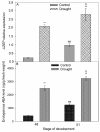Molecular and Hormonal Aspects of Drought-Triggered Flower Shedding in Yellow Lupine
- PMID: 31370140
- PMCID: PMC6695997
- DOI: 10.3390/ijms20153731
Molecular and Hormonal Aspects of Drought-Triggered Flower Shedding in Yellow Lupine
Abstract
The drought is a crucial environmental factor that determines yielding of many crop species, e.g., Fabaceae, which are a source of valuable proteins for food and feed. Herein, we focused on the events accompanying drought-induced activation of flower abscission zone (AZ)-the structure responsible for flower detachment and, consequently, determining seed production in Lupinus luteus. Therefore, detection of molecular markers regulating this process is an excellent tool in the development of improved drought-resistant cultivars to minimize yield loss. We applied physiological, molecular, biochemical, immunocytochemical, and chromatography methods for a comprehensive examination of changes evoked by drought in the AZ cells. This factor led to significant cellular changes and activated AZ, which consequently increased the flower abortion rate. Simultaneously, drought caused an accumulation of mRNA of genes inflorescence deficient in abscission-like (LlIDL), receptor-like protein kinase HSL (LlHSL), and mitogen-activated protein kinase6 (LlMPK6), encoding succeeding elements of AZ activation pathway. The content of hydrogen peroxide (H2O2), catalase activity, and localization significantly changed which confirmed the appearance of stressful conditions and indicated modifications in the redox balance. Loss of water enhanced transcriptional activity of the abscisic acid (ABA) and ethylene (ET) biosynthesis pathways, which was manifested by elevated expression of zeaxanthin epoxidase (LlZEP), aminocyclopropane-1-carboxylic acid synthase (LlACS), and aminocyclopropane-1-carboxylic acid oxidase (LlACO) genes. Accordingly, both ABA and ET precursors were highly abundant in AZ cells. Our study provides information about several new potential markers of early response on water loss, which can help to elucidate the mechanisms that control plant response to drought, and gives a useful basis for breeders and agronomists to enhance tolerance of crops against the stress.
Keywords: LlHSL; LlIDA; LlMPK6; abscisic acid; abscission zone; catalase; drought stress; ethylene; hormone homeostasis; yellow lupine.
Conflict of interest statement
The authors declare no conflict of interest.
Figures










Similar articles
-
Drought Disrupts Auxin Localization in Abscission Zone and Modifies Cell Wall Structure Leading to Flower Separation in Yellow Lupine.Int J Mol Sci. 2020 Sep 18;21(18):6848. doi: 10.3390/ijms21186848. Int J Mol Sci. 2020. PMID: 32961941 Free PMC article.
-
The influence of abscisic acid on the ethylene biosynthesis pathway in the functioning of the flower abscission zone in Lupinus luteus.J Plant Physiol. 2016 Nov 1;206:49-58. doi: 10.1016/j.jplph.2016.08.018. Epub 2016 Sep 21. J Plant Physiol. 2016. PMID: 27689739
-
EPIP-Evoked Modifications of Redox, Lipid, and Pectin Homeostasis in the Abscission Zone of Lupine Flowers.Int J Mol Sci. 2021 Mar 16;22(6):3001. doi: 10.3390/ijms22063001. Int J Mol Sci. 2021. PMID: 33809409 Free PMC article.
-
Molecular Mechanism Underlying the Effect of the Intraspecific Alternation of Seed Size on Plant Drought Tolerance.J Agric Food Chem. 2020 Jan 22;68(3):703-711. doi: 10.1021/acs.jafc.9b06491. Epub 2020 Jan 9. J Agric Food Chem. 2020. PMID: 31904950 Review.
-
Drought coping strategies in cotton: increased crop per drop.Plant Biotechnol J. 2017 Mar;15(3):271-284. doi: 10.1111/pbi.12688. Plant Biotechnol J. 2017. PMID: 28055133 Free PMC article. Review.
Cited by
-
Glomus sp. and Bacillus sp. strains mitigate the adverse effects of drought on maize (Zea mays L.).Front Plant Sci. 2022 Aug 17;13:958004. doi: 10.3389/fpls.2022.958004. eCollection 2022. Front Plant Sci. 2022. PMID: 36061768 Free PMC article.
-
Drought Disrupts Auxin Localization in Abscission Zone and Modifies Cell Wall Structure Leading to Flower Separation in Yellow Lupine.Int J Mol Sci. 2020 Sep 18;21(18):6848. doi: 10.3390/ijms21186848. Int J Mol Sci. 2020. PMID: 32961941 Free PMC article.
-
Disruption of the Auxin Gradient in the Abscission Zone Area Evokes Asymmetrical Changes Leading to Flower Separation in Yellow Lupine.Int J Mol Sci. 2020 May 27;21(11):3815. doi: 10.3390/ijms21113815. Int J Mol Sci. 2020. PMID: 32471291 Free PMC article.
-
Jasmonate-Dependent Response of the Flower Abscission Zone Cells to Drought in Yellow Lupine.Plants (Basel). 2022 Feb 15;11(4):527. doi: 10.3390/plants11040527. Plants (Basel). 2022. PMID: 35214860 Free PMC article.
-
Redox-Dependent Structural Modification of Nucleoredoxin Triggers Defense Responses against Alternaria brassicicola in Arabidopsis.Int J Mol Sci. 2020 Dec 2;21(23):9196. doi: 10.3390/ijms21239196. Int J Mol Sci. 2020. PMID: 33276577 Free PMC article.
References
-
- McKeown A.W., Warland J., McDonald M.R. Long-term climate and weather patterns in relation to crop yield: A mini review. Can. J. Bot. 2006;84:1031–1037. doi: 10.1139/b06-080. - DOI
-
- Ainouche A.K., Bayer R.J., Misset M.T. Molecular phylogeny, diversification and character evolution in Lupinus (Fabaceae) with special attention to Mediterranean and African lupines. Plant Syst. Evol. 2004;246:211–222. doi: 10.1007/s00606-004-0149-8. - DOI
-
- Wilmowicz E., Frankowski K., Kućko A., Świdziński M., de Dios Alché J., Nowakowska A., Kopcewicz J. The influence of abscisic acid on the ethylene biosynthesis pathway in the functioning of the flower abscission zone in Lupinus luteus. J. Plant Physiol. 2016;206:49–58. doi: 10.1016/j.jplph.2016.08.018. - DOI - PubMed
MeSH terms
Substances
Grants and funding
LinkOut - more resources
Full Text Sources

